Table of Contents
- Why use Linkedin?
- To take it a level further… why post on Linkedin?
- How to fit posting on Linkedin into your marketing strategy
- Should I post from my company page or a personal profile on Linkedin?
- What to write about on Linkedin when posting
- How to write for LinkedIn
- How to write a Linkedin post with the best chance of success
- Writing a good headline for your Linkedin posts
- Breaking down a successful Linkedin post
Why use Linkedin?
With 756 million users worldwide, Linkedin is the world’s largest professional network. More importantly for marketers – it’s also the platform where reach is easy to come by. Without meaning to spell it out too obviously – more of the right eyeballs in the right, business context, has the potential to create real business opportunities.
I’m speaking largely from personal experience in writing this article. Linkedin has been good to The Marketing Meetup and much of the growth of our community has been driven through the platform. So, for the benefit of the community, I thought I would share the things I’ve learned from experience of using the platform, specifically focusing on posting on LinkedIn.
To take it a level further… why post on Linkedin?
This piece is focused on posting on Linkedin, as I think it’s the biggest opportunity most people miss. Reportedly, only 1% of Linkedin users post content to the platform. This means even by posting, you’re already beginning to stand above 99% of other users on the platform.
Here we can see my own results from 2022 (note: these are found in Shield which is heavily recommended). While I do use the platform regularly – this gives you a view of what is achievable for a balding nearly 30 year old from his home office. Now imagine what you could do in all of your glory!
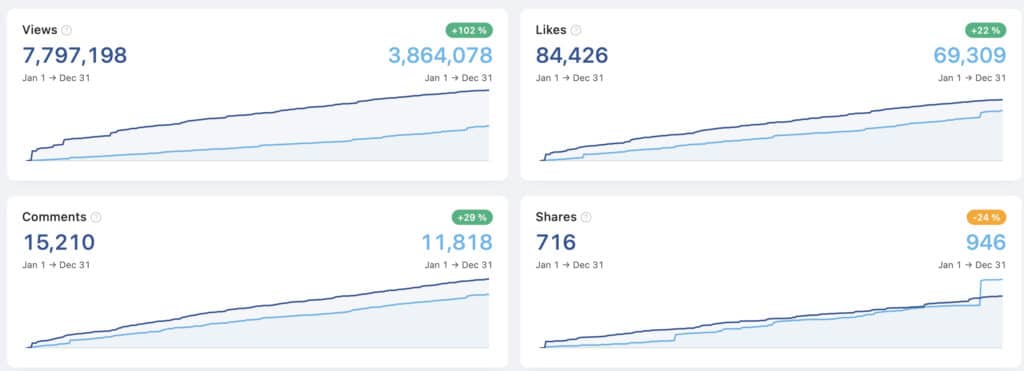
How to fit posting on Linkedin into your marketing strategy
Let’s be clear: opportunity is the currency of Linkedin.
As much as you might want sales – the benefits of engaging on Linkedin are far broader. From new friends to company awareness to speaking opportunities and yes… sales too. LinkedIn gives you opportunities across a wide spectrum of marketing goals.
So, rather than jumping straight into ‘how to post on Linkedin’ I think it’s worth spending a moment to understand ‘why would you post on Linkedin’.
Linkedin activity can’t stand on it’s own two feet without a proper strategy behind it. To do this, first investigate Mark Ritson’s Diagnosis, Strategy, and Tactics model found in this video.
Simply put – LinkedIn isn’t for everyone as a marketing tactic.
For example, if your target market is based in a country where Linkedin is blocked, there isn’t a great deal of sense in pursuing it as part of your tactical implementation. You have to make your own call on whether Linkedin is worth pursuing, but don’t take it as a given.
Assuming you’ve done the groundwork to decide that it is the right tactic to implement, then one of the best lenses for then looking at how Linkedin fits into your tactical implementation is the marketing lifecycle.
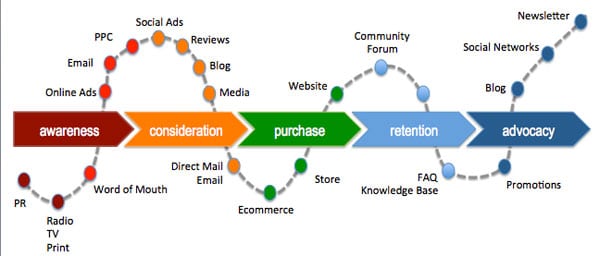
For my money, posting to Linkedin fits best within the awareness, retention and advocacy stages of the lifecycle, because…
- Reach is high, meaning more people can become aware of you and the problem you are solving. This fits at the awareness stage. Examples of awareness post is regularly found through ‘thought leadership’ content.
- At the retention stage, you can post as a reminder you are around. This shows continuous progress to clients and offers a behind-the-scenes view into your world. An example of a retention post could be posting a picture of you with a client at one of your meetings, or an appreciation post for the people who have helped get you to where to you are today.
- If clients or customers comment on your posts, this is a nice public record of satisfaction for other people to see. Even better would be a customer posting themselves. Advocacy in action!
Where people go wrong is by trying to turn it into an acquisition channel; using it at the consideration and purchase stages.
While it is not beyond the capabilities of Linkedin to drive acquisition – pushing it too aggressively is where you hear people moaning about too many sales pitches on Linkedin. My main point of encouragement here is don’t jump into asking people to buy, too early (or in better terms, just be a regular, respectful person and treat people how you would want to be treated yourself!)
Engagements = sales, right?
There is an elephant in the room here which is engagements don’t equal sales. To reinforce the point earlier made therefore… the currency of LinkedIn is opportunity of all forms – not just sales!
Equally, don’t value engagement for the sake of it! Here is two posts to show how posts can be made in different ways when the goal is different things.
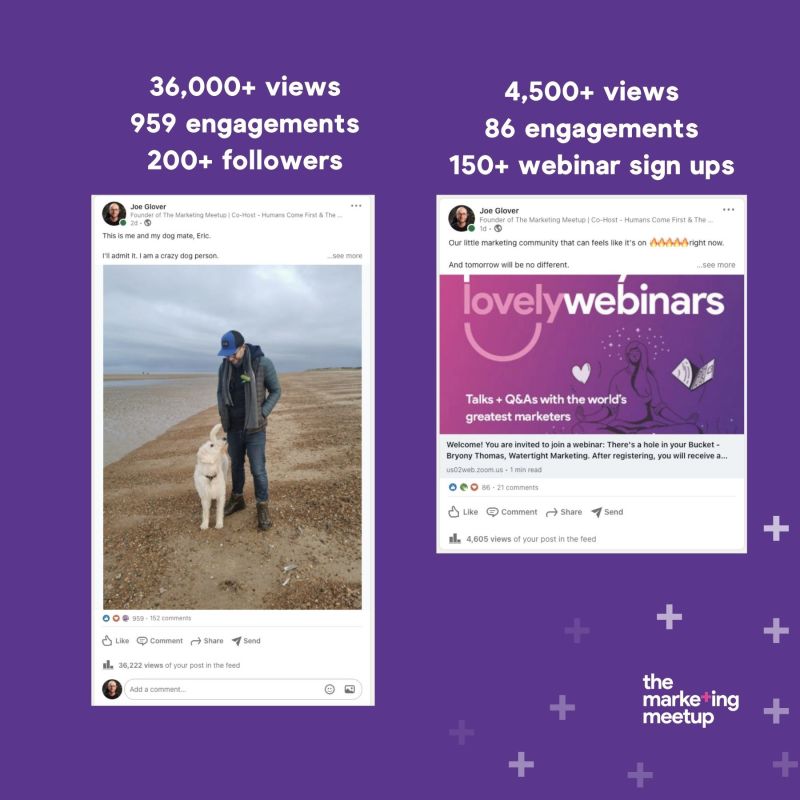
The left-hand post is an appreciation post to my dog. It was one of my most ‘popular’ posts – with lots of likes and comments. The second was a direct link to the webinar we ran previously. Not as many people liked that one.
So which is better?
Neither!
The first post gained a number of new followers and eyeballs on my content. That’s great in the long run.
However, the second had a direct impact on The Marketing Meetup there and then. More of the right people at our events is a fab thing. The impact was short and sharp.
The lesson is this: you have to know WHY you’re posting because how you judge success changes with the intention behind it.
Not only that – but you need to be layering in different kinds of posts: both long and short term to make the most of the platform.
Linkedin isn’t just about getting likes: it’s also a tactic for driving business results. Don’t just take likes/engagement as the only signal of success. Remember why you’re doing it!
And to wrap up this point…
Sometimes, and this is going to be controversial – you won’t be able to measure the ROI of your activity. Dave Gerhardt sums this up wonderfully.
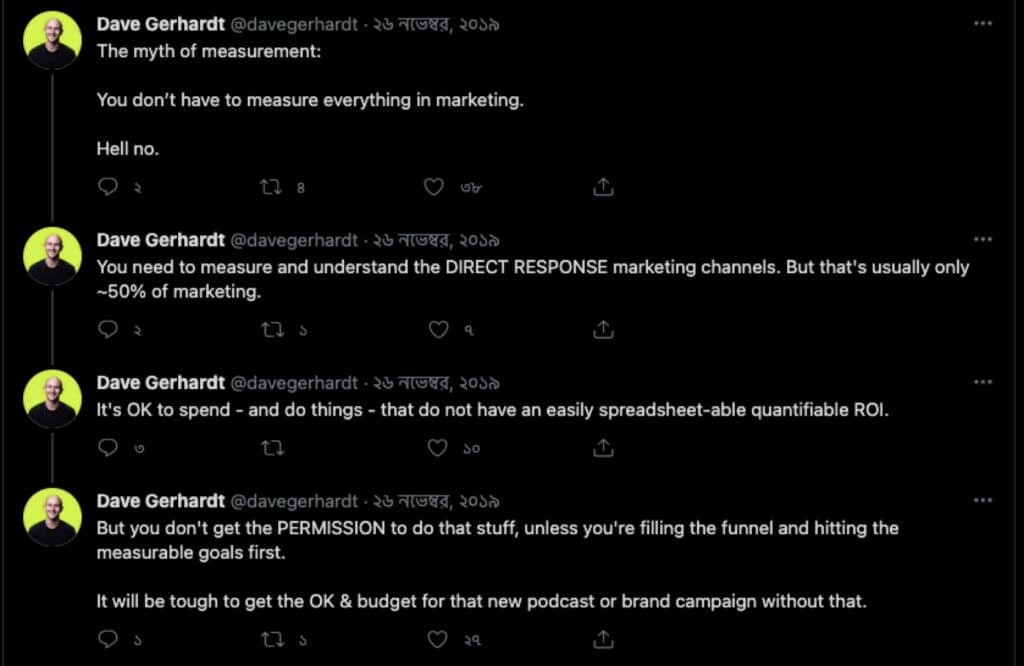
With this summed up, let’s move on to one of the next questions you regularly hear about Linkedin, namely – “Should I post from my company page or a personal profile on Linkedin?”
Should I post from my company page or a personal profile on Linkedin?
The answer here is pretty clear: the power of Linkedin sits in personal profiles. But recently company pages have shown some growth.
Last week, I posted the below. One from a personal profile, the other, from the company page.
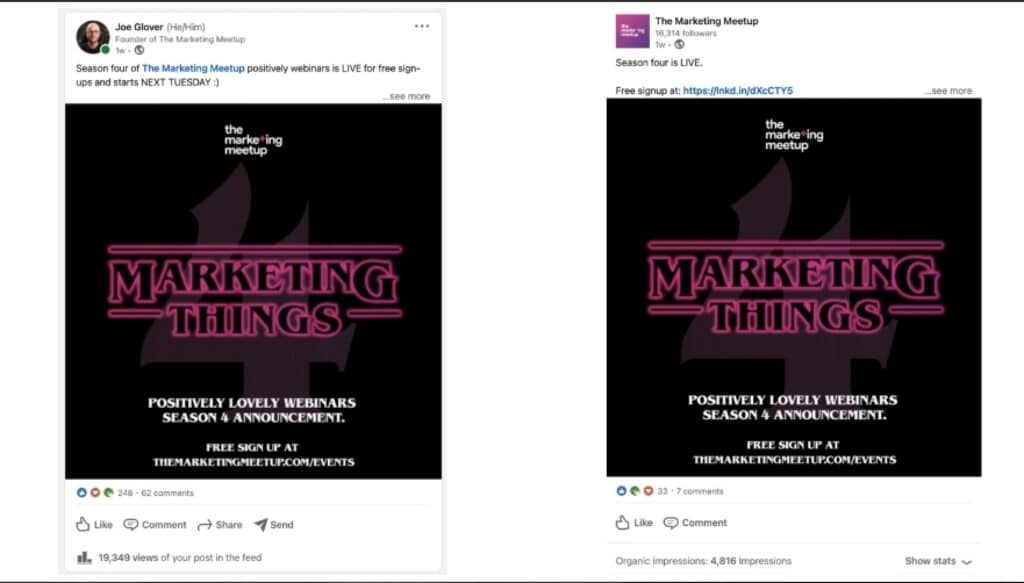
As this was an awareness based post, taking reach and engagements as a metric of success is okay. The results looked like…
|
Metric |
Personal |
Company |
Difference |
|
Reach |
19,349 |
4,816 |
301.765% |
|
Engagements (Likes or comments) |
310 |
40 |
675% |
While this is one sample from one person, it rings true to the experience of Linkedin. To take another example – Patagonia with it’s 546,380 followers only received 406 engagements from their most recent post. For a beloved brand such as this, the bang for the buck on engagement with posts is minimal.
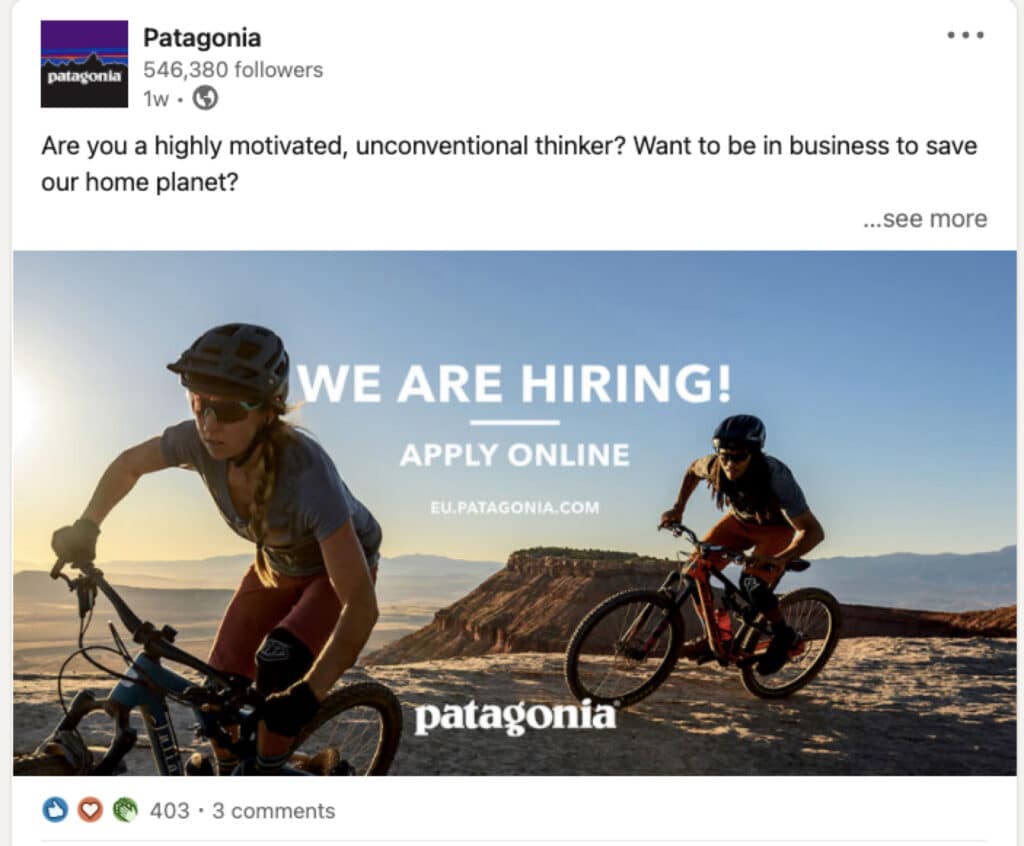
Compare this with Steve Bartlett, Katy Leeson, Mark Ritson, Helen Tupper, Eddie Shleyner and many more who all hit way more from this with significantly fewer followers, and it’s a clear indication that the algorithm favours people – not companies.
This has two implications.
- This conversation should now focus on posting from a personal perspective rather than a company page
- The benefits enjoyed from posting on Linkedin are linked to the benefits one experiences from personal branding. Which, if you’re not versed in, Ash Jones and Claudia Cardinali delivered a masterclass on personal branding which you may be interested in.
What to write about on Linkedin when posting
One of the most common questions when asking about how to get started with Linkedin is… ‘what do I write?!’
Well, having established that the platform is ‘people-first’ and has a business focus – write about the things that interest you in business.
What constitutes ‘business’ these days is broader than years of yonder – but I feel this should be liberating rather than paralysing. Don’t worry about the ‘This isn’t Facebook’ police – they’re probably not your people anyway.
Content pillars template
While ‘business’ gives you a remit to explore many different topics – I’d encourage you to focus on the subjects you would like to be known for.
The place we’re aiming for is to build a matrix that looks like the one below. To do this follow these steps:
- Identify what you want to be known for by answering the question ‘What are the three things I would like to be ‘famous’ for in the eyes of my customers?’. Ideally, you would have already established this at the strategy level so this will simply be a duplication of that.
- List all the topics associated with this topic that you are able to speak about.
- Decide what your narrative/opinion or story that you are going to tell about each sub-topic will be.
|
Topics I want to be known for |
Sub-topics |
Narrative |
|
Dogs |
Labradoodles |
They are the best breed |
|
Vs cats |
Better than cats | |
|
Training |
Training never ends | |
|
Equipment for dogs |
Cheaper is better than expensive! | |
|
Marketing |
PPC |
A worthwhile pursuit |
|
SEO |
Horrible, obviously | |
|
Community |
Building a community |
You have to do it with love |
|
Helping people |
Is the way to build community | |
|
Bringing people together |
Is the essence of humanity |
Through the creation of a table like this, you immediately have a whole bunch of content to create. What’s more, as time goes on, the table can also grow with more sub-topics.
Perhaps more importantly, this also gives you focus and consistency.
By giving guardrails to your creativity by saying you will turn up in the same shape, with a similar message, but with a slightly tweaked focus to your discussion. Over time, this builds up into a perception of who you are, and what you know about.
Reactive content on Linkedin
For 9 days out of 10, the above will suffice in terms of giving you inspiration for content creation. But, every so often a golden opportunity strikes.
Reactive content is content that is reacting to a significant event that is relevant to your topic (note here: not just any significant event – just the stuff that is relevant to you and your audience!).
Often, as content that falls into this category is something that is being shared as a human experience by other people – chances are this will have a higher emotional engagement and thus a chance of resonating with more of your target audience.
Take the below as an example. Two months ago, football owners attempted a cash grab – prompting an angry response from football fans. As one of my content pillars is about humanity over cash, it made sense to comment on the issue as this is the opposite of what I stand for.
Because the content was ‘in the moment’ and reactive, it was picked up by the Linkedin Editorial team and featured in their daily news roundup, meaning it became one of my best-performing posts of all time.
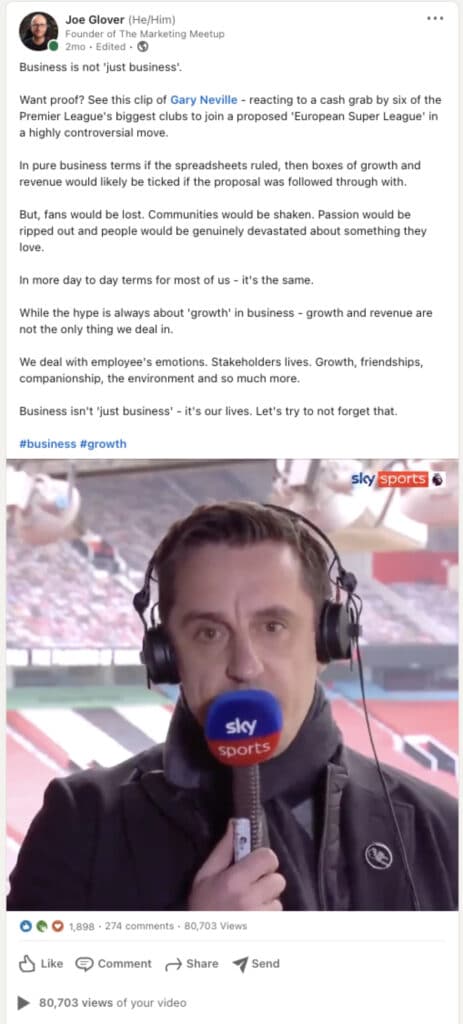
To find ‘reactive’ content, simply keep an eye on the news.
I use the BBC ‘most read’ feature and if something is recent, breaking news that is relevant to what I would like to be known for, I will add a comment. The key here really is speed because if you’re late – there are likely going to be many people who would have already made similar posts.
There is a word of warning that needs to be applied to reactive content: not everything should be reacted to.
Always keep in mind the question ‘is this in good taste to react to?’. Hopefully, I don’t need to explain that to you.
Avoiding thin content on Linkedin
Now, I appreciate much of the conversation around this topic has been around creating engagement on your Linkedin content.
There is a way to create engagement, that frankly, sucks. It also doesn’t give you any kind of return beyond likes for the sake of it and could in fact simply be damaging.
See this example:
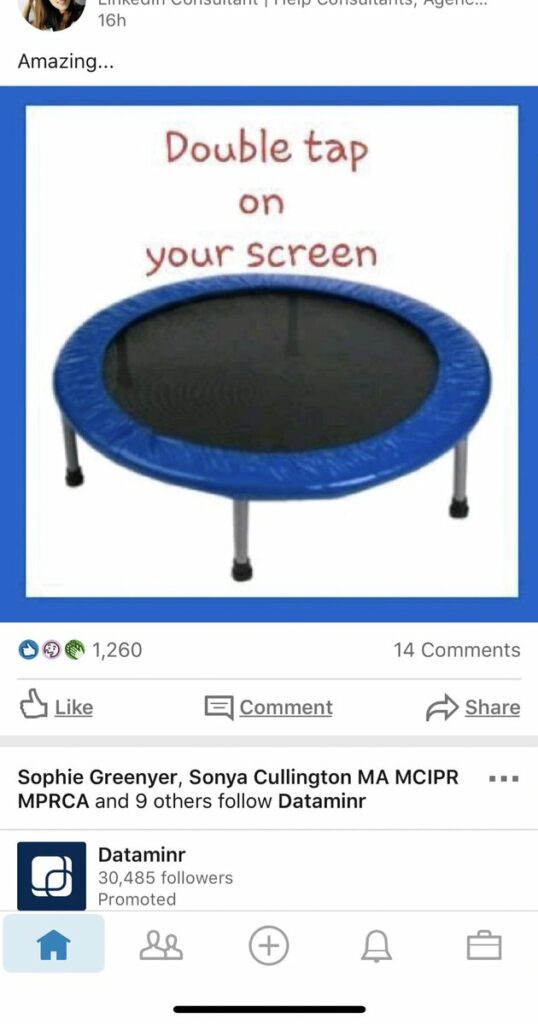
This kind of trampoline post is thin beyond belief in that it provides no use *at all* to the reading public.
With this in mind, there is a simple golden rule: “Does this provide value to anyone except me?”. If not – don’t post it! You might get likes, but it won’t do anything for you or your business.
If you’re resorting to trickery and cheap tactics to get people’s attention – you’re doing it wrong.
Find the people you can help best. Solve a problem. Help them improve their lives. Be honest. Frankly, that’s a far more fun approach to marketing, too.
A note on having the confidence to post on Linkedin
One of the final considerations about posting on Linkedin is having the confidence to do it.
This is far deeper than the remit of this piece but should be acknowledged. So here are my two pence.
You can’t control whether someone will enjoy your work.
But you can control how much love you put into creating it.
Chances are the second will radically influence the first.
That thing you’re worrying about – chances are… no one else really cares.
That’s not to be discouraging. It’s a message about liberation.
It’s not worth waiting on it. Push through it today and you’ll look back tomorrow wondering what you are worried about.
I’ve wasted time worrying about perceptions of my Linkedin posts. However, most people if they don’t resonate with something will just scroll right past. Even if they don’t – always remember not every person is ‘your’ person. It’s okay for some people to not like your stuff!
Doing it is the only way to get to the place you want to be, so don’t wait on it and don’t overthink it! 😊
How to write for LinkedIn
There is a definite ‘patter’ to posting on Linkedin, but the most important thing is you are writing in a way that represents you.
Going back to the point of confidence, it’s not worth writing anything you don’t stand by because you’re trying some ‘hack’ or ‘trick’ to make you stand out. First and foremost – do you.
If you are already doing you, however, here is a few tips you might want to take into your own posts.
Format – Pictures/slides/plain text/video/articles
To start, good content no matter the format is far more likely to succeed. However it would appear that Linkedin is prioritising certain kinds of format right now. Here is how I would rank them…
Posts with pictures
Posts with pictures seem to ‘fly’ the most in my experience (this is anecdotal, so test it out yourself!). They take up a good chunk of ‘real estate’ on the screen and demand less from the reader in terms of time involvement than videos.
The king of this is Harry Dry. When Harry posts, the crux of the benefit provided by his post is usually in the image, as seen below.
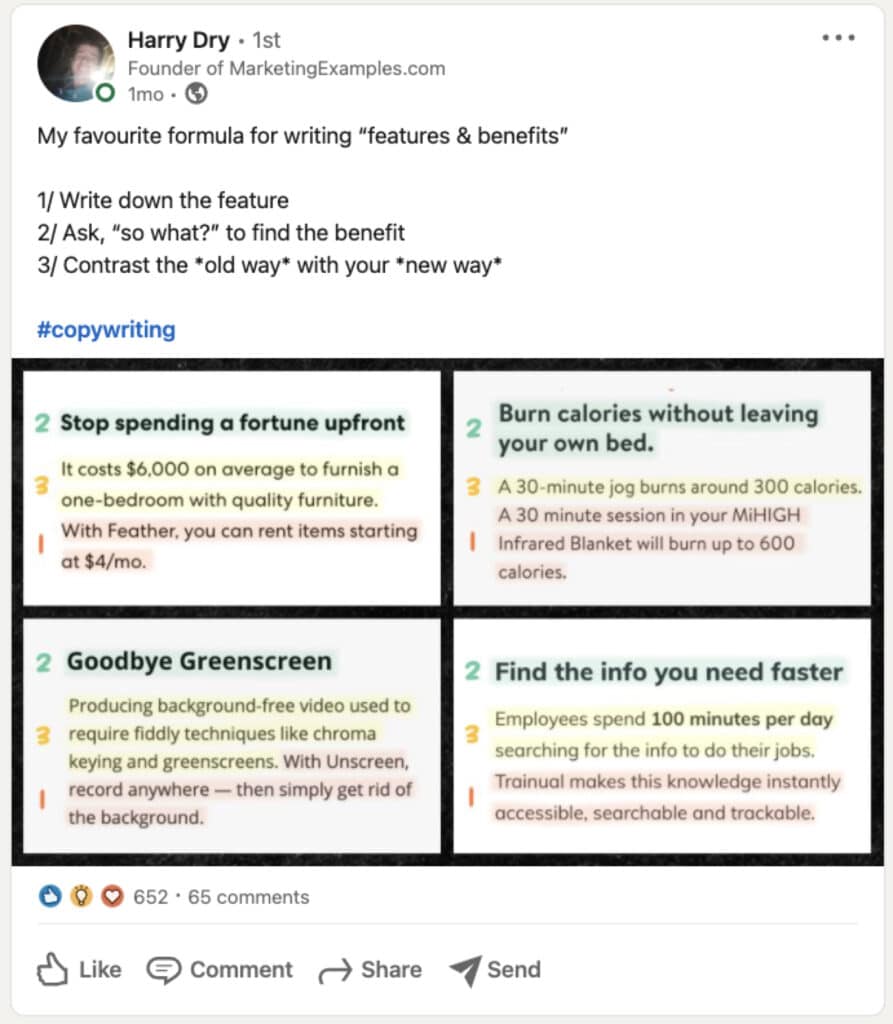
Now, Harry is exceptionally good at this kind of content and gives us something to strive for. For someone less good at it (yours truly), a simple image to reinforce your copy can also work as it helps take up more screen space, which is of course useful for your post when people are scrolling.
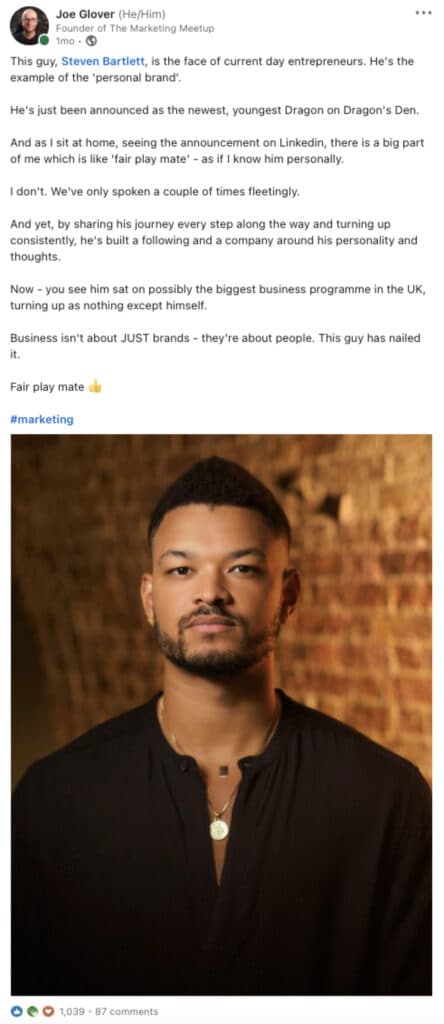
The key benefit of posting images are how they take up more screen space, while reinforcing (or indeed, making!) your point for you. The takeaway here: when possible, do use images!
Plain text
Plain text posts are easy to post, and easy to digest. They perform well on Linkedin (indeed, John Espirian would say better than image based posts) but can get lost in a busy feed.
The main advantage here is that the posts are very easy to engage with for the user, with minimal effort required on them to ‘get it’ and react.
Slides
Slide formats do the same as images, but give you the opportunity to elaborate further and tell a deeper story than a text only or single image post will allow.
Dan Kelsall uses this format regularly to great effect and often with humour.
The benefit of this format is the increased opportunity to tell your story with more depth, while still remaining concise enough that folks can skip through without having to commit minutes to find out what you’re speaking about. These posts are great when posted, but do take more effort to produce.
Video
Video is an interesting one on Linkedin. My experience of video on the platform is that it’s harder to get traction with them. This seemed to stay true to John Espirian’s recent experiment of posting a video every day on the platform to see what would happen.
Conversely, some of the comments I get most regularly in the real world relate to videos I have produced. To me, this speaks to a truth: video content hits differently. The trade off however, is that it is consumed by less people on the platform. Going back to the marketing lifecycle, you may choose to use a picture/plain text/slides for awareness, but video for consideration.
What is true however, is that for any video you produce… make sure you caption it! Too many people miss that bit. Here’s how to do that.
How to write a Linkedin post with the best chance of success
So (finally)… how do you write for Linkedin?
First and foremost, it’s about stories told well. Jeremy Connell-Waite knows a thing or two about this (https://themarketingmeetup.com/events/tell-stories-with-impact/), as does Dave Harland!
A story told well will…
- Capture the attention – Open with a strong hook
- Makes people read to the end – Keep the level of interest right the way to the end
- Get them to do something, feel something or think something – Make the reader take some type of action or learn something new.
- Be told with brevity, levity, clarity and charity
Once you know the story you want to tell, put together these five lines which will act as a structure for your post:
- An outline – Let your audience know what to expect
- A headline – A ten-word statement that encapsulates your story
- A front line – The most important point in the story should come first
- A side line or the body – Telling the story you want to tell
- A bottom line – Your call-to-action (for LinkedIn, this is optional! Not every post needs a CTA!)
Here’s some tips for creating Linkedin posts that land…
- Personal pronouns work best – ‘I’, ‘me’, etc. When writing from your Linkedin profile, you’re writing for yourself so speak like you would speak in real life to a friend down the pub.
- Break down your posts into short, digestible paragraphs. Unlike writing a blog post, You can get away with a new paragraph per sentence. This helps from both a readabilty perspective on mobile devices, but also takes up a larger amount of screen space when people click ‘read more’.
- Connective words at the beginning of each sentence such as ‘and’, ‘so’, ‘because’, ‘then’ all help stitch together a post into a coherent, single piece.
- The headline is the crucial real estate on your post. Make sure you’re making the most of it. We’ll investigate that more in a moment.
- Stop trying to do too much with your posts, focus on one thing and do it well.
- Your posts can be short or long. You have 1,300 characters to play with, but just like speed limits – that’s a maximum, not a target!
- Momentum really does get behind you – get in the habit of posting. Once a day has been optimum for me, but the important point is you need to get in a place which you feel comfortable with. Jeremy Waite (https://themarketingmeetup.com/events/tell-stories-with-impact/), as an example, gets great engagement from posting far less regularly and that works for him! Just do you!
- On the point of momentum, don’t expect results straight away! Building an audience takes time. I admire John Espirian’s (https://themarketingmeetup.com/blog/linkedin-john-espirian/) approach to building anything of value – encouraging folks to take a 30 month view on projects that really matter. I think the theory really applies to Linkedin activity.
- Don’t worry about Linkedin stories, they’re pretty rubbish and presently only available on the mobile app. Focus your energy on posting to the main feed.
- Don’t worry about sharing on Linkedin, either. The reach is trash. It really isn’t worth it.
- Don’t include links in your posts, where possible. I kinda hate it, but the ‘link in the comments’ tactic still seems to be effective.
- Tagging people in your post is a good thing. But, do it liberally. Nobody likes being tagged in a post that is irrelevant, or has a wall of other people also tagged in. Make sure it’s relevant if you are going to.
- I’m unsure on the real value of hashtags on Linkedin. But, it can’t harm. Limit it to three per post, however.
Writing a good headline for your Linkedin posts
If there is one skill that will really help you take things to the next level, it is perfecting the skill of the headline.
The goal of the headline is to capture the attention of a potential reader, to read on. This is doubly important as if your content is more than a couple of lines long, your content will be hidden behind a ‘read more’ button so your headline needs to work hard.

Katy Leeson nails this regularly. A short, sharp sentence that sums up what is coming, but also grabs the attention. The emphasis on ’NEED’ also makes this stand out more.
Dave Harland has a different approach, often choosing to be a bit odd with his opening lines. Again however, grabbing the attention of the reader.
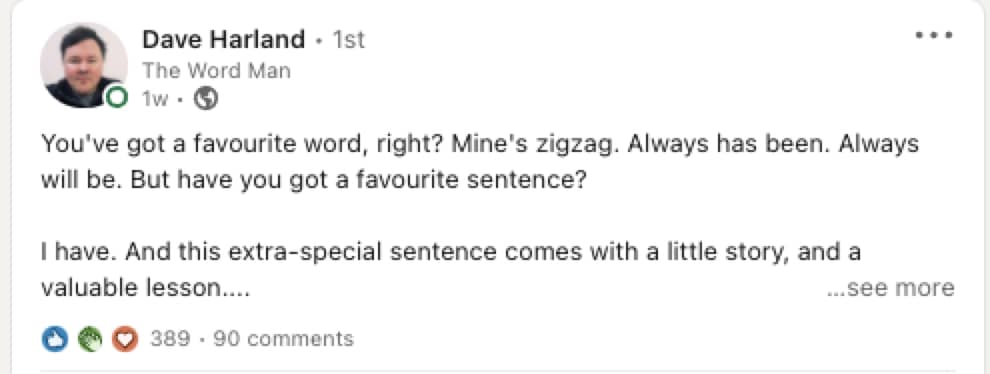
Chris Walker again shows someone making the most of the lines before the ‘read more’ tag kicks in. Bringing in the reader and compelling them to click.

And finally, David Hieatt nails it with this opening with a question.

So how do you find your headline?
The best tip I ever received on this is if you write your content – often the third sentence you write will be the one that turns out to be the one that will be used as a headline. This is often the key takeaway of the thing you are writing.
However, some more concrete ways to think about your first sentence could also come from these approaches, suggested by Convince and Convert,
- The storyteller’s opening – Draw the reader into a story already in progress – “Late on a Tuesday afternoon in April, they booted me out of their investor’s club because they realized I was onto their dishonest schemes.”
- The Suspense-Creating Opening Sentence – The effect you want to elicit after the reader reads this style of sentence is for them to wonder, “Wait . . . what?” – “I picked up the phone and heard my long-time client Sam say, “How do I slow down the orders coming in? I can’t keep up!” – Dave Harland above shows this
- The Compelling Question Opening Sentence – Ask questions that seem like the beginning of a story or that create a “Wait . . . what?” reaction – “Did you ever wonder why people wait for hours to get inside some restaurants, while other places sit empty? – David Hieatt shows this above.
- The Surprising Statement Opening Sentence – Make a bold statement that your content promises to back up – “I think 99% of most marketing is bull***t. Here is why.” The above example from Chris Walker shows this in action.
Breaking down a successful Linkedin post
Taking the above suggestions into account, let’s finally break down some Linkedin posts. As you can see, there is multiple ways to go about things, but each follows a similar structure.
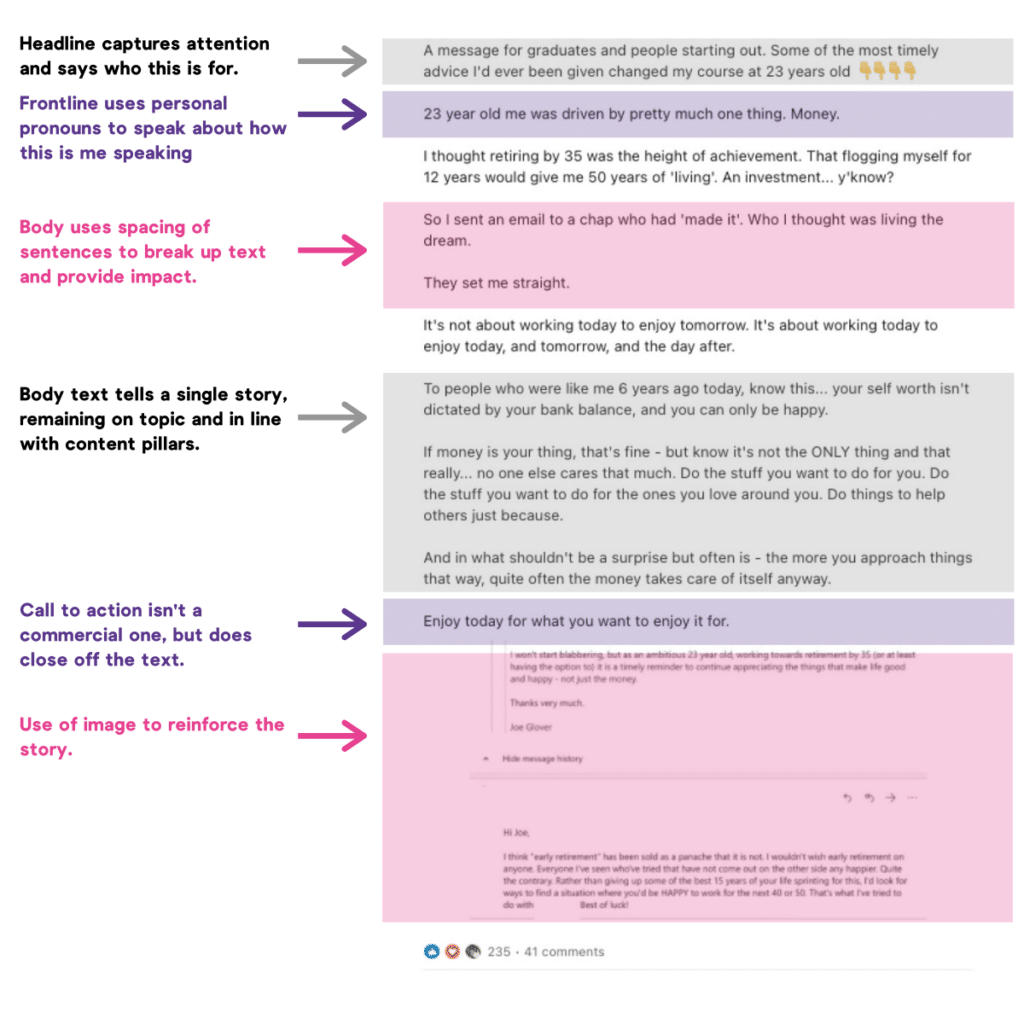
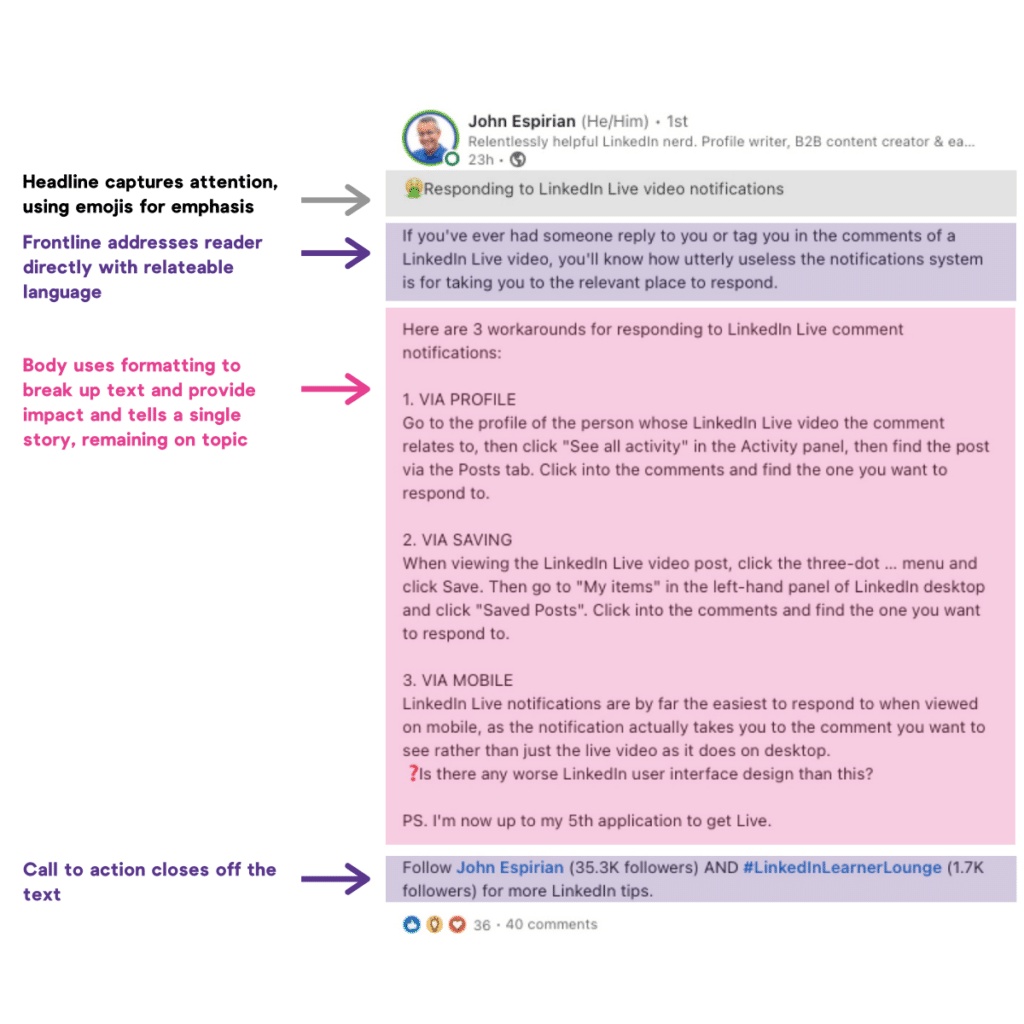
A final note on commenting
If someone comments on your stuff the rule is simple… reply! It’s important to acknowledge people who want to engage with you, but also has a secondary benefit of showing the algorithm there is life on the post, which will continue pushing it to more folks who may be interested.
And so, that’s it for now. I’ll add to this post as I go. I hope it’s been useful!
